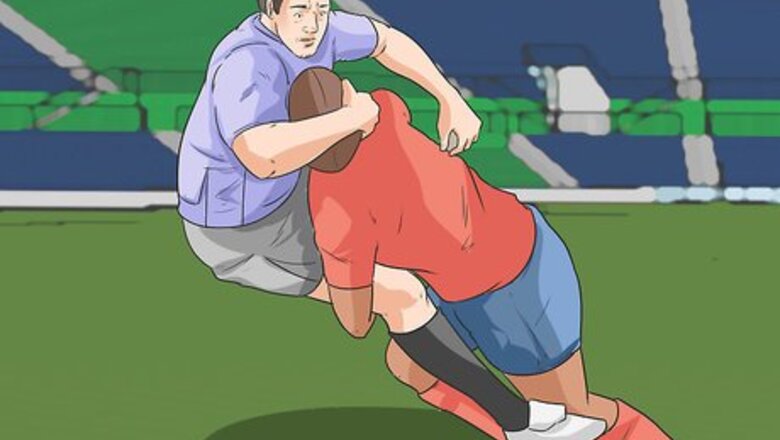
views
Tackling an Opponent
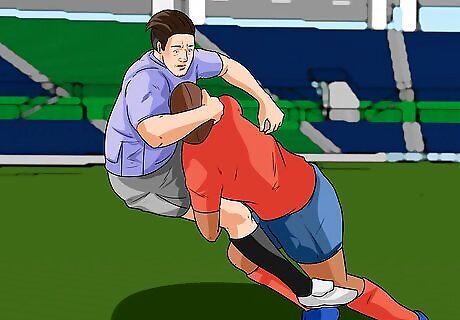
Tackle low, leading with your shoulder, to bring down any runner safely and effectively. A rugby tackle is quick, simple, and safe if you keep your head up and lead with your shoulder. A good tackle has several components, and mastering them will prevent injuries and bring down opponents with ease: Start in an athletic position, on your toes to adjust to the attacker's movement. Lead with your shoulder, driving it into their thigh or stomach. Keep your head up, tucking it along the butt of the attacker. Wrap your arms around their thighs, squeezing in to take them off balance. Let your momentum carry your shoulder through them, using your arms to "squeeze" them to the ground with you.
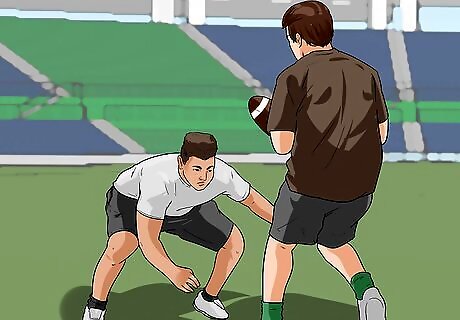
Bend your knees gently and crouch into an athletic stance as the runner approaches. You need to be ready to move in a moments notice as the tackle approaches. The best way to prepare is to be on your toes, knees slightly bent, and arms in front of you. Imagine an Olympic wrestler in their starting position and you have a good idea of your stance: Knees bent. Weight forward, on the balls of your feet and ready to spring. Spine straight. Hands out in front of your body, ready to tackle. Your elbows should not be "chicken-winged" outwards. Head up and looking at your opponent.
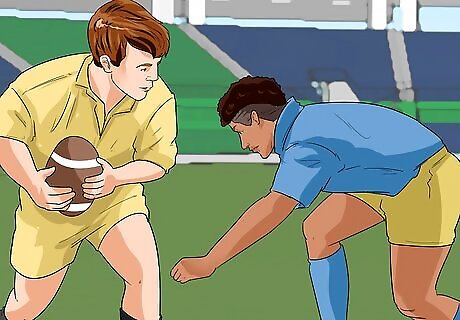
Step up to your opponent as they approach. Don't wait them to come to you -- take the tackle to them. As they run at you with the ball, take short, choppy steps to close the gap. Make the attacker make a decision before they're ready, all while staying on your toes and closing in. Once you're 1-2 meters away you're ready to start the tackle. If you're chasing them down, or running over, slow down and gain control of your body 5-10 yards away from them. You don't want to run at them. You simply want to move your feet with quick, short steps towards them, allowing you to change direction on a dime if they try and fake you out. Watch their waist as you approach. A player usually fakes with their head, their arms/shoulders, or their feet. A person's waist, however, must point in the direction their body is moving.
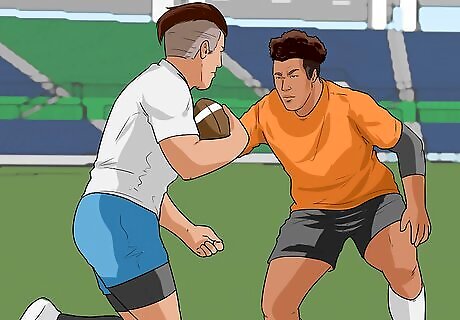
Step at the attacker once he is closer enough to tackle. This is how you build the momentum needed for a good tackle. Once you've closed the gap and know what direction he's going, step towards him, aiming roughly right between his legs. Once you've reached this point you need to be committed to the tackle, and the next few moves need to happen in rapid succession, without hesitation, to succeed. More often than not, the attacker will pick a side of you and run for that, trying to get around you. This actually makes your job even easier -- once they've picked a side you can step right at them and tackle from the side, as they've eliminated their forward momentum.
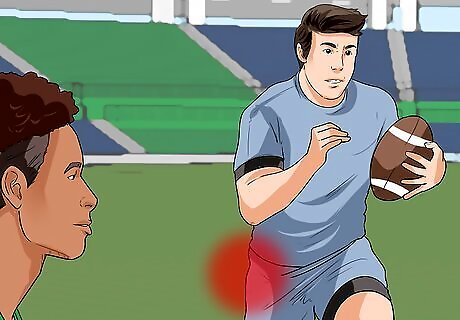
Find the "safe side" of the attacker when planning the hit. This is usually up to the attacker to decide, so be adaptable. The safe side is where you're going to place your head on the tackle. Most often this is their backside: a player chooses a direction to run around you, and you don't want to tackle them on the same side as their pumping knees and legs. For example, if an attacker runs to your right, the safe side would be on your left, right along the attacker's butt. In the rare instance when a player runs right at you without making a move, never fear -- keep your head up and step right at them, positioning your head to whatever side you're comfortable with.
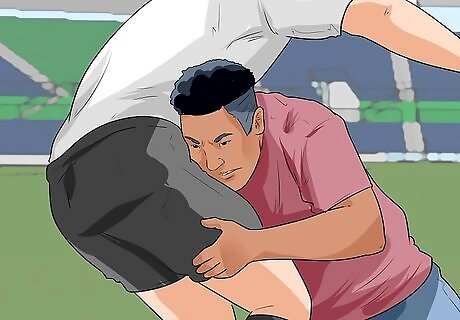
Throw your shoulder into their gut to initiate the tackle. Follow up on your big step by throwing your momentum, shoulder first, into the opponent's midsection. Your head needs to stay up to watch out for injuries, and your cheek will slide along their butt cheek if you've made proper contact. As you make the move, drive with your legs, pushing yourself "through" the tackle for the maximum power. Keep your elbows close to your ribs as you tackle, not out wide. The majority of your tackle is done with your shoulder and body weight, not your comparatively weak arms. You can hit anywhere between the upper thigh and just underneath the chest. Know, however, that the lower you hit the easier they will be to bring down.
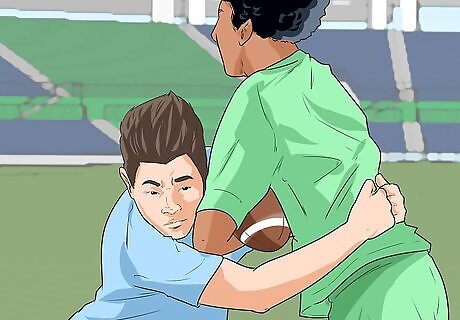
Wrap your arms around their thigh and squeeze in. This is the best way to pull someone off balance, no matter how much bigger or stronger they are. After you've made contact, wrap your arms around their legs and squeeze into your chest, like you were giving their thighs the biggest hug you can give. When warming up with teammates, practice this quick grip and squeeze around the thighs. You'll notice how easily your teammates lose their balance and get lifted off the ground.
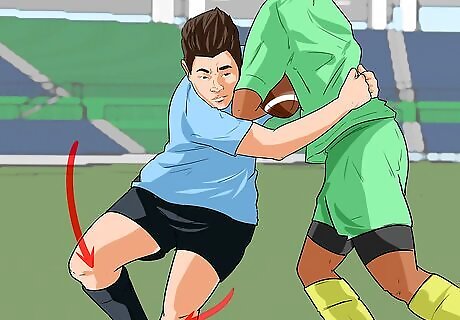
Keep driving with your legs to bring them to the ground. Once you've made contact and wrapped up their legs, keep your legs moving and arms squeezed to bring them to the ground. More often than not you'll end up on top of the tackle, making it easier to get up and join the ruck. If you've lost your footing on the tackle, keep squeezing with your arms. If this doesn't bring them down on its own another teammate will soon be there to finish the job. Keep your feet moving the entire time you're tackling. You want to be constantly in motion and driving the opponent back. Once the player is down, jump back up to your feet immediately. You cannot keep playing the ball from the ground, but once you're on your feet again you can grab the ball or ruck for your team.
Practicing & Coaching Tackling
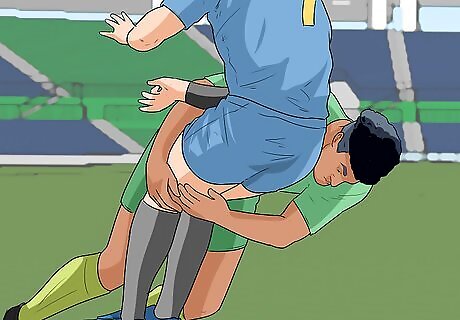
Practice making appropriate contact and head position with drills on your knees. Get a partner. One of you should have a ball, they other will be on their knees 5-6 meters away. Have the ball carrier approach at half speed, then choose a direction to run around the "defender." The player on their knees must then commit to the tackle from the ground, focusing on placing their head on the opponent's butt cheek and wrapping them up. When done correctly, the wrap alone should bring the attacker down safely. This is a great drill for beginners and to warm up for tackling before practices and games. As you get better, try the same drill on your feet. Line up across from the attacker and make a slow, technically perfect tackle, bringing them to the ground gently. You can turn the drill an endurance test as well. Place 3-4 defenders, all on their knees, in a row and make the attacker run through each of them, taking contact and bouncing up after each hit.
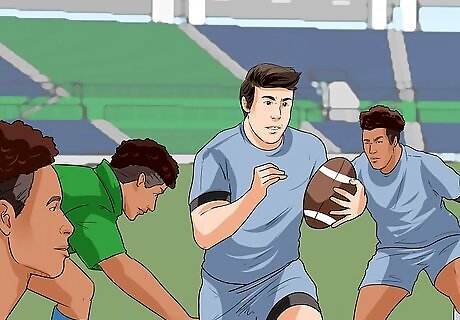
Try group tackling drills. Group 5 players in square, with one in the middle holding a ball. Have them toss it to a player on the corner, who will run in at them, choosing a side to run to. The center player must get low and make the tackle, then get to their feet and grab the ball. As the tackled player gets up and returns to the corner, have the center player throw the ball to a new person and then make another tackle. Switch out the player in the center after 1 minute or so, depending on skill and fitness level. Start with very small squares so that attackers can't gain much momentum. Once you're confident in everyone's tackling ability, increase the distance so that players must make more challenging tackles in the middle. Similar drills can be done in straight lines, where the tackler must move through everyone, or in small 2v2 scrimmages.
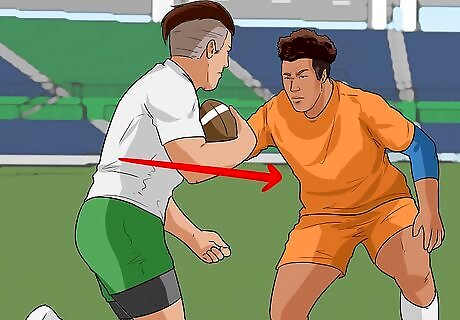
Practice jogging tackles once your form feels correct. The best way to get used to game pace is to slowly ramp up the contact. For jogging tackles, simply have an offensive player jog straight forward with the ball. Approach them diagonally and tackle them from the side, without them dodging at all. While you should still practice this at only 75% pace, it gets you used to hitting a moving target and placing your head correctly on the butt.
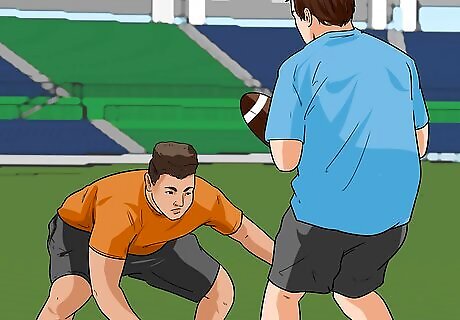
Work on one-on-one match-ups to improve your overall tackling. Oftentimes the best way to practice tackling is to just go and do it. Mark off a thin rectangle, no more than 10 yards wide, and give your teammate the ball on the end. Have them run at you at attempt to get by with whatever move, trick, or speed they can muster. Your only job is to prevent it from happening. Keeping the field thin allows you to approximate a game setting, when an attacker would just hit another defender by going out wide, and forces you to make solid, firm contact in order to win. To minimize head-on contact, start both players on the same side of the field. On the count of three, both players run around opposite corners of the box and then meet in the middle of the rectangle at an angle. In practice it is generally best to practice tackling at 75-80% speed. No one wants to get injured, especially in practice.
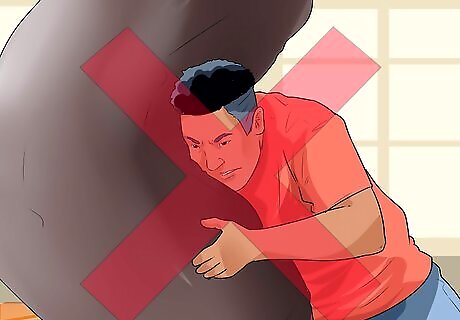
Do not over-rely on tackling bags. A tackling bag is a good, safe way to learn contact. However, many coaches use them far too often, which teaches kids to make odd tackles that they would never make in a game. Use the bags to warm-up, practice some contact on days where you don't want anyone hurt, and to illustrate where to hit with your shoulder. Otherwise, stick with natural contact, even if it is only at 50% speed, to teach your players more effectively. Tackle bags are soft and safe, meaning players can take tackling risks they never would in a game. Bags have a place in training still, of course, just not every day.
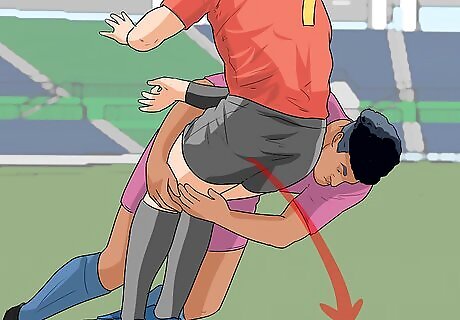
Practice "landing" tackles and getting quickly back to your feet every time. No matter what drill you are doing, you need be focused not only on the tackle but immediately after. A good tackler is back on their feet immediately, using the tackle to gain an advantage over the opponent that could lead to a stolen ball. As your tackling improves, work on. Ending the tackle on top. Make sure you get up before they can. Popping immediately to your feet. Once you're on your feet you can play the ball. That means, if none of their teammates have made it to the ruck yet, you can simply steal the ball and run forward. Step over the ball as soon as you're up. This ensures the ball is in your possession, even if you can't pick it up. The other team must ruck through you to get the ball back.













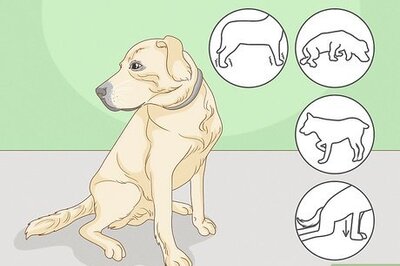
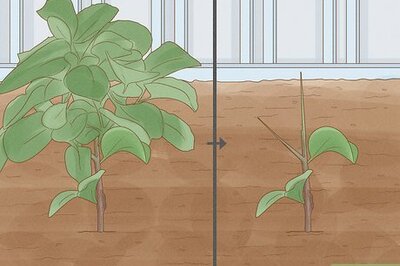




Comments
0 comment